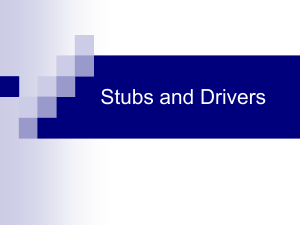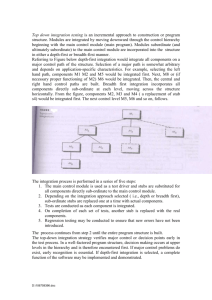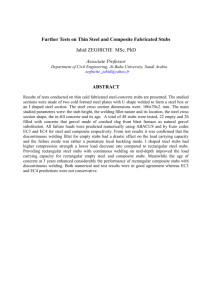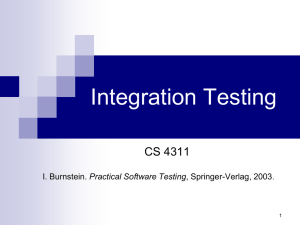Advanced Solutions for Modern Aluminium Smelters
advertisement
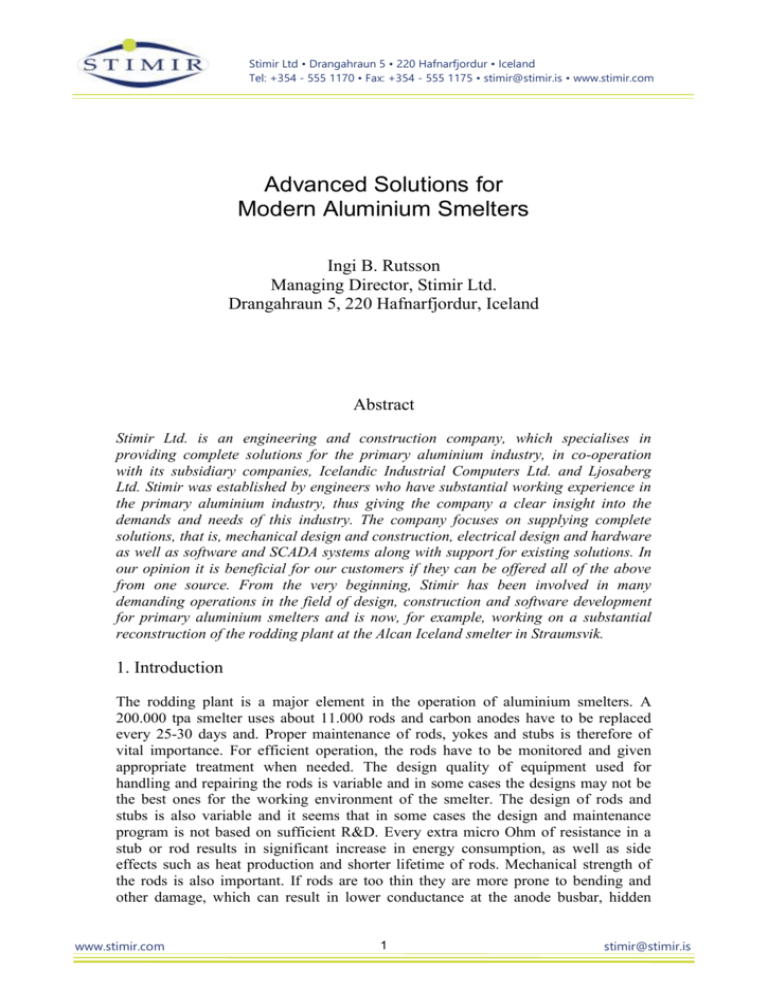
Stimir Ltd • Drangahraun 5 • 220 Hafnarfjordur • Iceland Tel: +354 - 555 1170 • Fax: +354 - 555 1175 • stimir@stimir.is • www.stimir.com Advanced Solutions for Modern Aluminium Smelters Ingi B. Rutsson Managing Director, Stimir Ltd. Drangahraun 5, 220 Hafnarfjordur, Iceland Abstract Stimir Ltd. is an engineering and construction company, which specialises in providing complete solutions for the primary aluminium industry, in co-operation with its subsidiary companies, Icelandic Industrial Computers Ltd. and Ljosaberg Ltd. Stimir was established by engineers who have substantial working experience in the primary aluminium industry, thus giving the company a clear insight into the demands and needs of this industry. The company focuses on supplying complete solutions, that is, mechanical design and construction, electrical design and hardware as well as software and SCADA systems along with support for existing solutions. In our opinion it is beneficial for our customers if they can be offered all of the above from one source. From the very beginning, Stimir has been involved in many demanding operations in the field of design, construction and software development for primary aluminium smelters and is now, for example, working on a substantial reconstruction of the rodding plant at the Alcan Iceland smelter in Straumsvik. 1. Introduction The rodding plant is a major element in the operation of aluminium smelters. A 200.000 tpa smelter uses about 11.000 rods and carbon anodes have to be replaced every 25-30 days and. Proper maintenance of rods, yokes and stubs is therefore of vital importance. For efficient operation, the rods have to be monitored and given appropriate treatment when needed. The design quality of equipment used for handling and repairing the rods is variable and in some cases the designs may not be the best ones for the working environment of the smelter. The design of rods and stubs is also variable and it seems that in some cases the design and maintenance program is not based on sufficient R&D. Every extra micro Ohm of resistance in a stub or rod results in significant increase in energy consumption, as well as side effects such as heat production and shorter lifetime of rods. Mechanical strength of the rods is also important. If rods are too thin they are more prone to bending and other damage, which can result in lower conductance at the anode busbar, hidden www.stimir.com 1 stimir@stimir.is Stimir Ltd • Drangahraun 5 • 220 Hafnarfjordur • Iceland Tel: +354 - 555 1170 • Fax: +354 - 555 1175 • stimir@stimir.is • www.stimir.com damage of bimetal joints, causing e.g. increased electrical resistance. Proper design and maintenance of rods and stubs is therefore of vital importance. People are also becoming more and more conscious of the need for good safety measures in the rodding plants and these considerations need to be incorporated into any project at its conception. In this paper a discussion will be given on issues relating to maintenance of rods and stubs, selection of equipment and the use of resistance measurements to monitor the state of rods. 2. Criteria for Selection of Equipment All modern rodding plants have a large selection of equipment, each one serving a specific purpose, but all working together to give a certain output and product quality. Though the purpose here is not to consider each individual item we will however focus on the criteria which are useful to have in mind when selecting equipment for the rodding plant, such as quality and performance of each unit, output rate, maintenance, how the unit fits into an older production line (if there is one) and how much it costs. In all cases it is important to plan the project well. If a new unit is placed in an older production line, the stoppage time must not become long, which means project coordination must be good. General The equipment must be well designed and suitable for the rodding plant in question. Each smelter circumstances are unique and only in very few cases is it possible to use the same equipment unchanged in two smelters. The equipment design has to be tailored to the circumstances of each smelter. This applies to the function of each unit, mechanical strength, software design, maintenance and cleaning access, as well as employee safety. It is also important that the design does not include unnecessary features which are extravagant or not useful, such as over-design regarding output rate, mechanical strength etc. Ergonomics The nature of the working environment in rodding plants is such that it usually takes much effort to keep it clean and tidy. It is nevertheless a very important issue because it affects the general feeling and opinion people have towards their job. It can certainly be stated that increased cleanliness reduces accidents, and that handling of equipment and quality of work improves. It is our opinion that several things regarding ergonomics and cleanliness can usually be improved in the typical rodding shop. We have often noticed how little emphasis designers place on this aspect. It is our sincere belief that proper attention needs to be paid to ergonomics and cleanliness at the design stage. Damage to equipment and high maintenance cost can often be related to an unattractive working environment, which results in less respect of the employees for their general working environment. Examples Conveyor belts for rod transportation are used in all rodding plants. Diverse variations of these are used, such as chain railings and cylindrical conveyors. All of these have www.stimir.com 2 stimir@stimir.is Stimir Ltd • Drangahraun 5 • 220 Hafnarfjordur • Iceland Tel: +354 - 555 1170 • Fax: +354 - 555 1175 • stimir@stimir.is • www.stimir.com in common that carbon from the anodes collects and settles under them, which in many cases can be difficult to remove and clean. This is usually very noticeable in rodding plants, but it is relatively easy to solve if taken into account at the design stage, and an example of a solution to this problem can be found at Stimir. Graphite coating of stubs is a good example of a procedure that often causes much dirtiness in the rodding plant. After the stubs have been dipped into the graphite bath and while being transported from it, the new coating often drips off onto other equipment or the floor. Most of the time, it is not possible to refill the bath without making a considerable mess. Recently, much consideration has been given to stub coating using dry carbon powder. This means that stubs don’t have to be heated after coating, thus reducing explosion danger in the casting process. An equipment of this type is a part of Stimir´s ongoing refurbishment project for Alcan Iceland in Straumsvik. Collar Filling Machines are another example of equipment capable of causing much dirtiness. Several things can contribute, such as inaccurate placing of collars, insufficient adjustment to different types of rods, wrong filling rate, uneven distribution, unnecessary vibratory equipment and inaccurate assessment of quantity. All these shortcomings can be limited or even totally eliminated with the right measures. These measures are not necessary costly, if attention is given to the problem at the design stage and emphasis is placed on making the equipment friendly for the working environment. Any added cost incurred will certainly pay in the long run. 3. Safety The issue of work safety has become a more prominent issue in recent times. It is therefore important to consider safety aspects from the beginning, when selecting equipment. This reduces cost and ensures that the equipment fits well into the particular rodding plant. It can also be said that the “danger level” associated with machinery varies, even if their function is the same. Important contributors to this are the basic ideas which are used in the design process of the equipment. A more specific and targeted design delivers a lower risk level and more efficient machinery. Shields have to be placed over all movable parts and they also have to be easy to remove for maintenance. Warning and instruction signs have to be clear and access for maintenance and cleaning has to be good. In many cases it can be useful or necessary to limit access to a certain machine. Access control may have to be set up which makes it possible for operators to enter without risk. In such cases it may be necessary to make appropriate arrangements in the control of the equipment, so that e.g. before access is allowed, the machine has to finish it’s current work cycle and then position itself in a safety position. In that way the disturbance associated with access can be minimized. www.stimir.com 3 stimir@stimir.is Stimir Ltd • Drangahraun 5 • 220 Hafnarfjordur • Iceland Tel: +354 - 555 1170 • Fax: +354 - 555 1175 • stimir@stimir.is • www.stimir.com 4. Cost Cost is always a big issue in the decision making process, both when new equipment is placed in an older line, and also when a new greenfield plant is set up. We would like to point out a few things which can significantly affect the cost, seen from the perspective of the contractor. Goals and requirements A key factor in all projects is to specify clearly what the outcome should be. Several things need to be considered like output rate, safety goals, how much automation is required, ergonomics and maintenance to name but a few. Clear specifications defined at the initial stages almost guarantees that the cost of the project is minimized and the equipment will be more effective. Over-design. One of the things that often cause considerable extra cost is over-design. An example is when the output rate of a certain machine is much higher than what is actually needed or when mechanical strength is much greater than necessary. Such design can often be the cause of other problems, not to mention higher cost. The floor conveyors can again be pointed out as an example of this. Engraved cylinders for locomotion are more expensive than the smooth variation and for long conveyors the cost difference can be considerable. In our opinion, the engraved cylinders are the worse choice in most, if not all cases. They cause more vibration, which leads to more dust accumulation and higher wear and tear of the equipment. If tracks are synchronized properly, smooth railings can be used without any problems. Another example is stub alignment. Some are of the opinion that stubs need to be heated before adjusting for the cowboy effect. We are however convinced that in many cases this is an example of over-design, causing considerable extra cost in both investment and maintenance. Cold straightening of stubs is done in many rodding plants with good results. The maximum force or deformation may have to be set to avoid breaking highly bent stubs. This is particularly appropriate when new equipment is set up where stub straightening has not been done before. Stimir is currently designing a stub straightening machine in collaboration with Alcan Iceland in Straumsvik as a part of our development project there. Project cointegration In our opinion it is important to overall efficiency that the same contractor is responsible for all aspects of a given project. Many contractors are usually involved with the implementation of each project, such as machine designers, electrical designers, software designers, mechanics, electricians, electronical engineers and so on. Stimir Ltd. has been built up with this in mind and we offer solutions with everything included, from design to in-situ testing of equipment. As a result, only one contractor manages the project, from beginning to end. For the buyer, this minimizes organization of each project and allows the contractor to use its manpower more efficiently. Good contact between all parties involved in a given project is also important, particularly where installation of new equipment must not stop production, except for a short time. For the buyer and the contractor it is therefore important that the whole package can be offered from one source. www.stimir.com 4 stimir@stimir.is Stimir Ltd • Drangahraun 5 • 220 Hafnarfjordur • Iceland Tel: +354 - 555 1170 • Fax: +354 - 555 1175 • stimir@stimir.is • www.stimir.com Selection of stubs and yokes It is well known that many types of yokes and stubs are used in smelters throughout the world and it is difficult to say which configuration is best for any given circumstances. It is however clear that mechanical strength is important as forks can bend and/or their bimetal joints can sustain damage while being handled. Resistance in rods and stubs is of course always kept as low as possible. A 200.000 tpy smelter uses about 11.000 rods, so it is very important that the most appropriate configuration of yokes and stubs is selected for that particular situation. Every additional micro Ohm of resistance in a stub can mean an increase in energy expenditure of 1.3 GWh per year. 5. Maintenance of stubs and yokes Maintenance of stubs and yokes is an integral part of every rodding plant and various methods are used for repair and renewal. The most common damage to stubs is thinning and damage from the cryolite bath, bending of outermost stubs (cowboy effect) and elongation (stretching). When stubs are badly damaged they are replaced, either by melting them off using gas or by sawing them off, after which new stubs are welded on the yoke. Sawing off stubs has several benefits over using gas. In August 2001, Stimir installed a new type of stub sawing machine in the rodding plant of Alcan Iceland that uses a band-saw instead of a conventional wheel blade. The specifications by Alcan Iceland stated a certain minimum number of stubs per hour, cutting accuracy, and a minimum cutting capacity per blade. The saw would have to be automatic and read bar codes for information about which stubs to cut. It was also required to fit into the already existing process line and located where the burners were previously situated. Apart from the direct financial benefits of the new stub saw, it has also resulted in a much better working environment, due to the fact that cutting with gas is both noisy and messy along with polluting. Stimir´s new stub sawing machine on the other hand is both clean and almost silent and all the debris that accumulates is collected into a special container, which is emptied each shift. The cut from the stub saw is much cleaner and smoother than was possible using gas and hence the quality of the welds has improved much. This again results in lower resistance over the replaced stubs. Stub Sawing Machine qualities highlight: • Annual reduction of energy requirement is about 1.1 GWh due to less resistance (cleaner cutting). • Annual reduction of CO2 emission is about 15 tons as propane gas is no longer used. • Increased quality of welded replacements as cuts are cleaner and smoother than before. • Increased precision of cut, resulting in a more even length of stubs. • Economic for the welding process as the surface of sawn-off stubs is smooth. • Better working environment • Saves annually about 2000 working hours. • Voltage drop across stubs about 36% lower. • Noise level under 80 dB (A) • A more even length of stubs means that less cast iron is used and it improves current distribution. www.stimir.com 5 stimir@stimir.is Stimir Ltd • Drangahraun 5 • 220 Hafnarfjordur • Iceland Tel: +354 - 555 1170 • Fax: +354 - 555 1175 • stimir@stimir.is • www.stimir.com Principle of Stimir´s Stub Sawing Machine Rods with damaged stubs are labeled with a bar code, which is fastened to the yoke. For a three stub yoke, there are seven sawing possibilities. The rods come to the saw by a ceiling railway and are not taken down. They pass a bar code reader on its way into the saw and information about the sawing method is read into a PLC machine, which controls the sawing process. An operator is needed to fasten bar codes on rods at the beginning of each shift, change blades and add cooling liquid if necessary. The PLC machine monitors the state of the saw blade and gives a signal when replacement is needed. The specifications from Alcan Iceland required 80 stubs per blade, but on average the blades have lasted about 150 stubs. Resistance measurements to monitor state of stubs and bimetal joints A station to measure resistance of rods is a part of the development project Stimir is working on in collaboration with Alcan Iceland. The resistance is measured from the rod, above the bimetal joint, through the yoke and stubs. The station is located in the process line, after the stub-straightening station.When stubs have been straightened, a fork is sent into the station. Clamps are fastened, with automatic equipment, to the rod above the bimetal joint and the stubs. Current is then set on the rod, the voltage drop measured and the resistance calculated by Ohms law. An approximately 100A current gives a fairly accurate measurement of the resistance. The purpose of this is as manifold: 1. Handling of rods, particularly when anodes are replaced, can damage the bimetal joints in a way that is difficult to see. This causes an increase in resistance which is detected by the measuring equipment. 2. The quality of stub welds varies. If the weld has a serious defect it can significantly increase the resistance of the stub. 3. It is possible that stubs break when they are straightened, either at a weld or at the yoke. The station is therefore located after the stub straightening station, to enable detection of defects and flaws. Where welding is done automatically, the resistance measurement can detect if the quality of welds deteriorates. If resistance exceeds a certain reference level, the rod is automatically sent to a specific location for closer inspection. A station like this can also be a good addition to the tracking system. It is then possible to have a complete record of all resistance measurements and compare them with reference to their location in the potline, stub repairs and which shift repaired or replaced them. A station for resistance measurement can therefore be a valuable addition to the overall management of quality in the rodding plant. 6. Conclusions Design and manufacture of equipment for rodding plants and aluminium smelters in general is a demanding challenge. Each unit has to be considered individually, but attention must also be paid to the production line of which the unit is a part and to the overall specifications set on output rate, maintenance, quality, safety, ergonomics etc. The contractors must have good insight into and experience of the circumstances and work methods in each smelter. Stimir Ltd has designers and engineers which www.stimir.com 6 stimir@stimir.is Stimir Ltd • Drangahraun 5 • 220 Hafnarfjordur • Iceland Tel: +354 - 555 1170 • Fax: +354 - 555 1175 • stimir@stimir.is • www.stimir.com individually and collectively have a long experience of working in this field. We place great emphasis on providing solutions which uniquely fit each situation. Our goal is to design, develop and build new equipment and improve older equipment, meeting the specific needs and demands of each situation with emphasis on quality, safety and user-friendly working environment. References ISAL tíðindi, 17.10.2001/ Tindasög / Bjarni Jonsson, Alcan Iceland www.stimir.com 7 stimir@stimir.is

